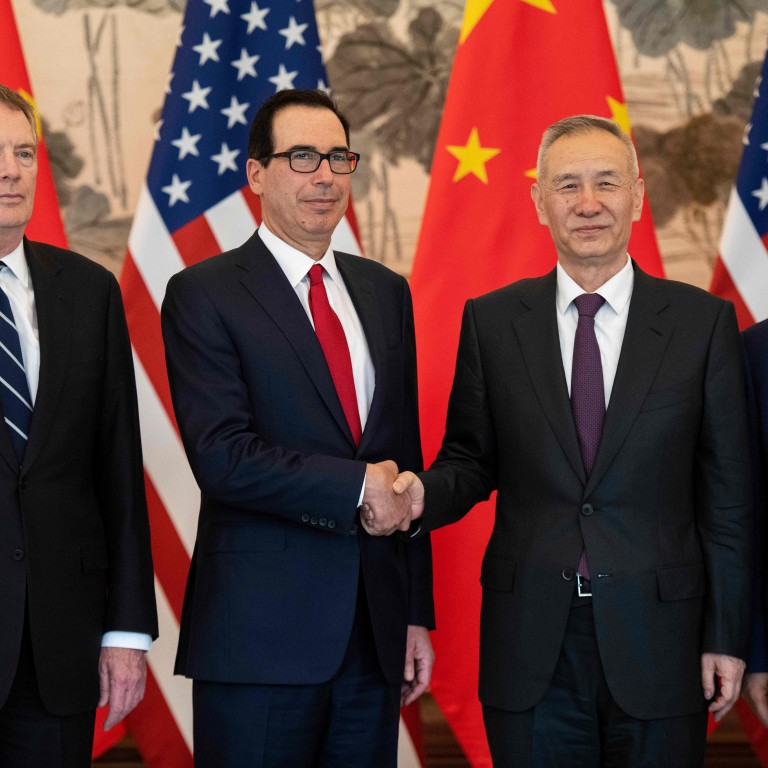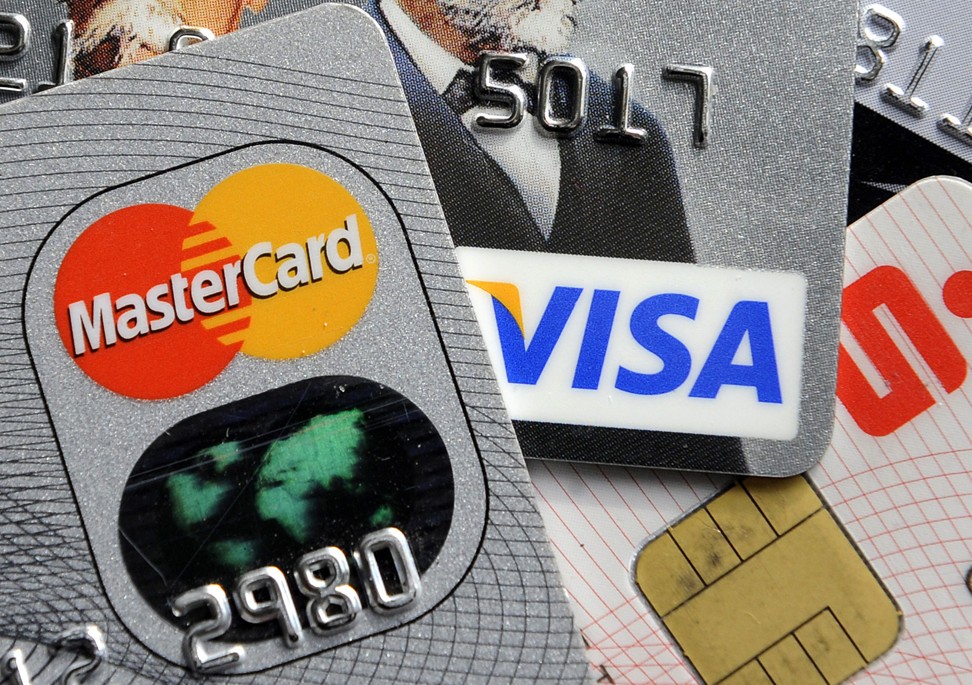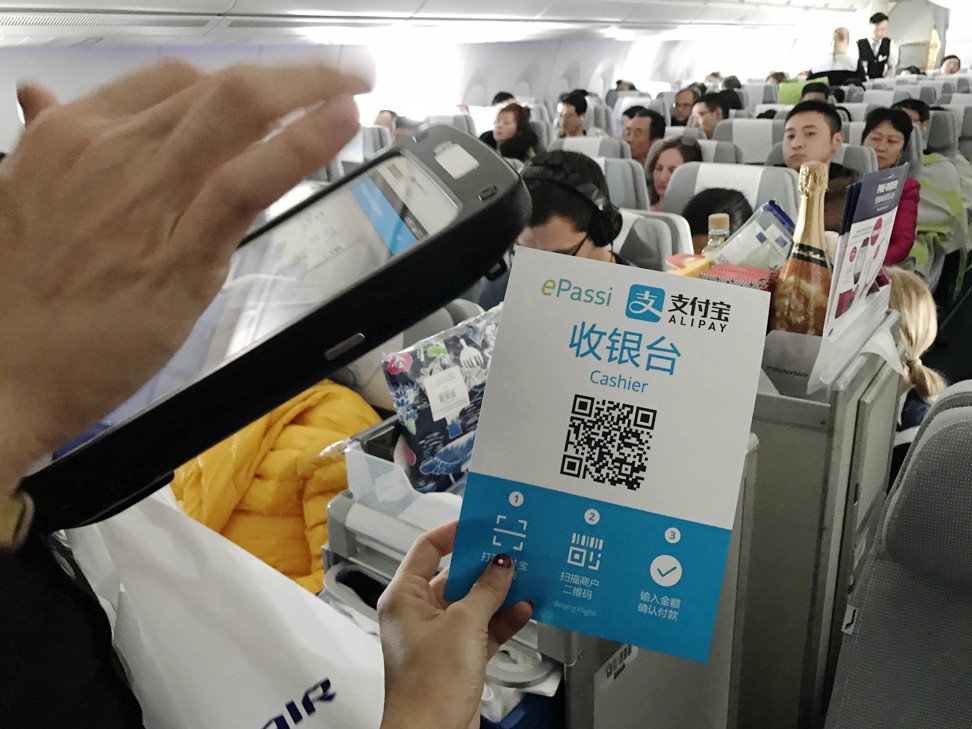
US-China trade war deal could be too late for the likes of Mastercard, American Express and Visa
- China promised to allow foreign firms into its domestic electronic payments market by 2006 having joined the World Trade Organisation in 2001
- The administration of Barack Obama failed to resolve the issue, Donald Trump has taken up the cause with President Xi Jinping
This story is part of an ongoing series on US-China relations produced jointly by the South China Morning Post and POLITICO, with reporting from Asia and the United States.
A trade deal between President Xi Jinping and United States counterpart Donald Trump could finally fulfil a long-delayed promise to open up China’s 208.1 trillion yuan (US$31 trillion) market for credit cards and other third-party payment processors to American companies like Mastercard, American Express and Visa. But any agreement reached might be too little too late.
Beijing promised to allow foreign firms into its domestic electronic payments market by 2006. Instead, foreign firms have faced continued obstacles, despite a seemingly successful a World Trade Organisation case brought by the US to pry open the market. Only now has China finally established a two-step application process for foreign companies to receive a licence to provide electronic payment services.
Even if Xi and Trump resolve the issue as part of a broader agreement to defuse the bilateral trade war, it could take another two years before Visa, the largest US payments company, is able to offer its services in China. And then comes the challenge of wooing away consumers from a well-established brand.

Chinese consumers have been increasingly using their mobile phones rather than credit or debit cards to make purchases – a shift that has fuelled the tremendous growth of Tencent’s WeChat Pay and Alibaba’s Alipay mobile payment alternatives. Alibaba is the owner of the South China Morning Post.
In addition, since China’s entry into the WTO in 2001, China’s UnionPay has grown from a government-backed credit card start-up into an international behemoth with a substantial home field advantage.
Take the case of Thomas Potter, an American teacher who, when he lived in Beijing, did not use a Visa or Mastercard account because he knew it would not be accepted in most locations. Last year, however, he moved to Macau, a special administrative region of China, where he has found it relatively easy to use cards offered by US payment companies.
As has become clear, China’s industrial policy objective is to protect its national champion, China UnionPay, from competition in China so that it can use the revenues from a captive domestic market to fund its own global expansion.
“This year is the first time I had a Visa linked to a Chinese bank and I haven’t had an issue yet,” he said.
By contrast, Zheng Juan, a 53-year-old Chinese woman who visited the US in March, said UnionPay offered her an additional option to how she paid when she travelled overseas.
The UnionPay card even worked when she paid for her stay at a Comfort Inn in Michigan. Such a method of payment “was impossible seven or eight years ago when I first came to the US. It is much more convenient,” Zheng said during a shopping trip with a friend at Macy’s in the Fashion Centre of Pentagon City, a big shopping centre outside Washington.
But Zheng said she also kept a Visa card handy. “After all, it is just the beginning of UnionPay’s global usage. I still feel more assured to have a widely-accepted payment card, Mastercard or Visa, in case there are some shops that don’t accept UnionPay,” she added.
American officials insist the struggles of US credit card companies are clear-cut cases of China not living up to its trade promises, effectively stalling foreign competition until a Chinese competitor has cornered the domestic market.
In February, US trade representative (USTR) Robert Lighthizer, the lead negotiator in Trump’s talks with China, said the obstacles American companies still face entering China’s electronic payments market were a “conspicuous ongoing example” of its failure to honour its WTO obligations.

“As has become clear, China’s industrial policy objective is to protect its national champion, China UnionPay, from competition in China so that it can use the revenues from a captive domestic market to fund its own global expansion,” the USTR said in February in its latest report to Congress on China’s compliance with its WTO commitments.
Recently, American Express received preliminary approval to offer electronic payment services in China, but winning operational approval from the People’s Bank of China (PBOC), China’s central bank, could still take another year.
Meanwhile, UnionPay already accounts for the vast majority of cards issued in China. It also has expanded to account for about 44 per cent of the 15 billion credit, debit and other payment cards in use worldwide at the end of 2017, according to RBR, a research and consulting firm. By contrast, Visa accounts for 21 per cent of the world market and Mastercard 16 per cent.
UnionPay is also rapidly penetrating the global market that Visa, Mastercard and American Express used to dominate. Its network has expanded to 174 countries, and more than 100 million UnionPay bank cards have been issued in 50 foreign countries and regions, according to its online statement.
UnionPay has also been able to make huge inroads in the US as tourism and business ties have grown rapidly in recent years. An estimated 3.5 million Chinese citizens are expected to visit the United States this year, according to a US Commerce Department forecast. They spent about US$35 billion on travel, accommodation and other expenses in 2017, the department said.
“If [China] had opened as promised, Alipay and WeChat Pay would have had serious competitors earlier on, and I believe China’s payment landscape would look very different today,” said Martin Chorzempa of Peterson Institute for International Economics in Washington.
If [China] had opened as promised, Alipay and WeChat Pay would have had serious competitors earlier on, and I believe China’s payment landscape would look very different today.
In the last five years, the financial payments sector in China has changed drastically as electronic payments using mobile phones have become widely used in larger Chinese cities and are growing rapidly in the rest of the country.
Last year, Chinese consumers used their mobile phones to make 57 billion transactions, a rise of 61 per cent from a year earlier and up from only two billion such transactions in 2013, according to the annual payment service report released by the PBOC in mid-March. Mobile payments represented 35 per cent of all payment transactions last year.
“Visa and Mastercard won’t be able to change the payment culture that Chinese consumers have formed in the past decade. They have missed the golden era,” said Wang Pengbo, an analyst at Chinese internet consultancy Analysys.
The value of mobile payments in China has already surpassed that of traditional payments handled by credit card companies and other non-bank payment processors, with mobile payments topping 277 trillion yuan (US$41.3 trillion) in 2018.
“The cashless, cardless culture will continue to thrive in China. It’s impossible to return to a less convenient way to pay,” said Lei Ying, assistant professor at Guanghua School of Management of Peking University.
WeChat Pay and Alipay together account for more than 90 per cent of the Chinese mobile payments market, according to Analysys. Still, Chinese travelling overseas are more likely to find vendors that accept Visa and Mastercard, each of which are available in over 200 countries, and American Express, which is estimated to be available more than 160 countries.
“They [Visa and Mastercard] will be particularly focused on tapping those within China who travel overseas frequently. Despite the expansion of UnionPay, WeChat and Alipay in overseas markets, using Visa and Mastercard when abroad is still much easier than using Chinese payments systems currently,” said Michael Yeo, research manager for financial and retail insights at IDC.
Chinese tourists made 140 million overseas trips in 2018, up 13.5 per cent compared to the previous year, according to statistics from the China Tourism Academy, and one third of their transactions were made via mobile payments, overtaking cash for the first time, according to a Nielsen survey from January.
However, around 21 per cent of Chinese tourists who travel abroad said they have never used WeChat Pay or Alipay in a foreign country, with 61 per cent of those saying they did not know they could, or that mobile payments were not offered by merchants, according to research by consulting firm Kapronasia, which polled 1,000 Chinese consumers.
China told the WTO in July 2013 it had complied with a ruling that it had opened its markets, although during the last three years of the Obama administration until 2017, officials repeatedly pressed China on the issue with little success. In October 2014, China’s State Council announced its intent to allow foreign firms into the electronic payment services market, but it did not issue an official decision confirming the opening until six months later.
That decision created a two-step application process for companies to receive a licence to provide electronic payment services in China, and it also directed the PBOC to issue regulations to implement the licensing process. However, China’s central bank did not issue the final rules until June 2016.
In the following months, the PBOC also provided additional information to help firms navigate the application process, but the Obama administration left office in January 2017 without China having granted any of the licences.
China remains a vital market for us and we look forward to working with the Chinese government and local partners in growing and developing the overall payments ecosystem in the long-term.
The Trump administration then took up the issue as part of talks on a 100-day action plan launched by Trump and Xi at their initial meeting in Mar-a-Lago in April 2017. A month later, that effort produced some early results, including a pledge by China “to issue any further necessary guidelines and allow wholly US-owned suppliers of electronic payment services to begin the licensing process” by the end of the 100 days.
Instead, the entire 100-day process collapsed in July 2017, when a meeting in Washington failed to produce a sufficient enough breakthrough to satisfy the US president. A few months later, the USTR launched a broad investigation into Chinese intellectual property practices that eventually led Trump to impose tariffs on US$250 billion worth of Chinese goods, and Beijing to retaliate on US$110 billion worth of US exports.
Trump’s tariffs led to sporadic negotiations with Beijing throughout much of 2018, culminating in a temporary 90-day truce that came out of a meeting with Xi in December on the sidelines of the G20 summit in Buenos Aires. Chinese regulators helped set the stage for the meeting by announcing in November that American Express had received the first part of their approval to build a network to offer electronic payments services, although the final approval is still more than a year away.
Another issue the US raises has to do with the fact that the WTO required China to open the market to wholly foreign-owned companies, but many firms have little choice but to enter in joint deals, with American Express setting up operations with Chinese fintech services company LianLian as a joint venture partner.
Mastercard said in January it planned to submit a new application, after reportedly withdrawing its original in June 2018, and it subsequently resumed its push for a joint venture with online clearing house NetsUnion Clearing.
“China remains a vital market for us and we look forward to working with the Chinese government and local partners in growing and developing the overall payments ecosystem in the long-term,” said Ling Hai, co-president for Asia-Pacific at Mastercard.

Visa, the world’s largest payments company outside China, is also still waiting after submitting its application a year ago.
“The electronic payments issue is low-hanging fruit, having been previously agreed by both governments under the 100-Day Action Plan in 2017,” said a Visa company statement. “Resolution of this long-standing issue would be a positive signal of China’s continued commitment to financial reforms and market opening.”
For its part, UnionPay has a commercial routing arrangement with American electronic payments company Discover to facilitate acceptance of its cards, which are used primarily by Chinese travellers in the US.
And a joint venture would be a sensible choice for foreign businesses to enter the fast growing and rapidly changing Chinese market, given Beijing’s long-standing focus on data and financial security, said Guo Tianyong, a professor of finance at the Central University of Finance and Economics in Beijing.
“After all, China’s information and internet management policies are different from other countries,” Guo said. “Visa ultimately needs to bring forward a feasible plan to address Chinese regulators’ concern over data security, despite the upcoming bilateral talks.”
Additional reporting by Wendy Wu

